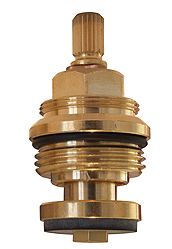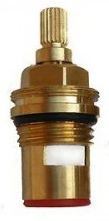|
A tap is
simply a device with the means to control the flow of water through it. This
is achieved opening, closing or restricting the path along which the water
will flow.
There are
countless designs of tap (also known as a faucet) to accommodate personal
taste and application, but they all share a similar function.
There are
several ways to achieve such control. but many domestic taps with
either one or two knobs or levers use one of two types of valve shown below.
Single lever taps tend to use a different type of cartridge - please refer
back to previous page or call if you require advice.
Compression washer tap
valve
These are more commonly seen in older and
traditional style brassware. Often known as a 'tap gland'.
They operate by multiple turns of the tap head
that screws a plunger in and out, in turn placing pressure on or releasing a soft washer
located over an orifice in the tap body. This action constricts the flow over water through
the orifice.
Although there
can be the odd exception, these can normally be identified prior to
dismantling if the tap head
requires multiple turns to operate fully. |
 |
Ceramic
disk tap valve
These are more commonly used in modern brassware.
A ceramic disk valve offers
full flow control (fully on to off) within a quarter turn of the tap head.
This makes
lever control possible - something that could prove difficult if
multiple turns were necessary.
Ceramic disk valves (also
referred to as ceramic cartridges) tend to last longer than their
traditional 'compression' counterparts - especially in hard water areas. |
 |
Replacing a tap valve
Replacing
either type of valve should be a fairly simple task. The valve (or
cartridge) simply screws into the body of the brassware, so extraction is a
matter of unscrewing. For a few simple tips on this process
please refer here.
For reasons
too numerous to list tap valves and cartridges are available in a
considerable range of sizes. A Bath tap may have a larger valve than basin
brassware in order to facilitate higher flow rates. Quirky and traditional
brassware my require a longer stem. Many tap stems have 20 teeth on the spline where others
may have 18, 24 or other number. These are just a few examples of possible
differences you may encounter.
In short,
take nothing for granted. Many tap valves can look similar but small
differences can mean that they will not interchange.
As tap
manufacturers tend to buy in the internals (the valves) it is usually
possible to source replacements whether or not you know the make and model
of the brassware. You just need to establish a few key dimensions.
How to measure a tap valve... |